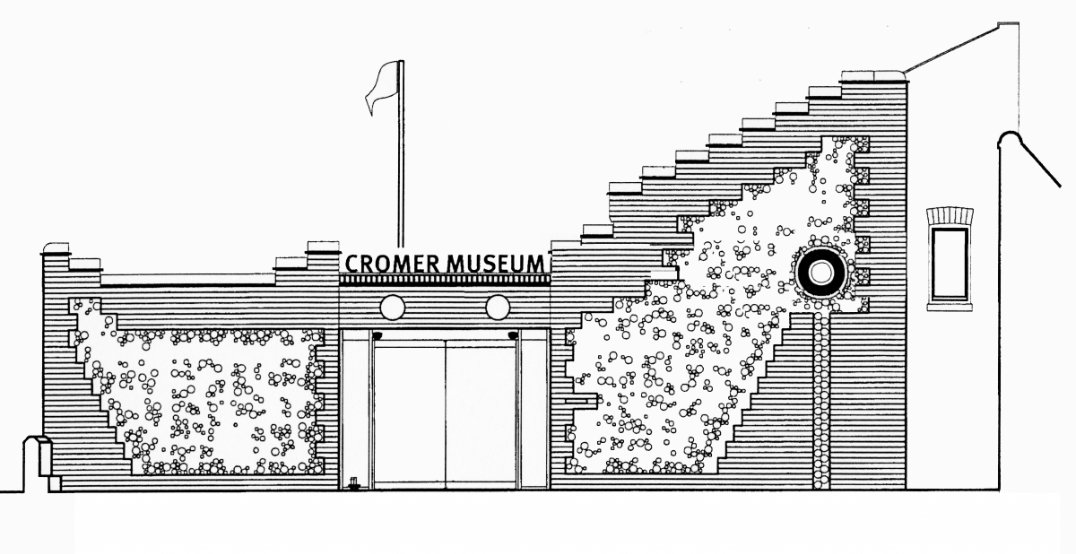The Prehistoric Landscape of North Norfolk
The north Norfolk coast is a remarkable region where geology and human history intertwine to create a landscape rich in stories of transformation. From ancient geological shifts to the impact of ice ages and the activities of early humans, this area offers a unique glimpse into the distant past. Its cliffs, marshes, and archaeological sites reveal a fascinating narrative of natural forces and human ingenuity.
Geological Foundations: A Landscape in Flux
The story of the north Norfolk coast begins over 600 million years ago, with dramatic shifts in the Earth's crust. East Anglia rests on a platform of ancient rocks that once formed part of a highland region.  The horth Norfolk cliffs at Hunstanton, where the chalk is at its highest level befoe dipping to the east of the countyOver time, this area alternated between being high land and submerged beneath the sea, creating the varied landscape we see today. Evidence of these changes is visible at Hunstanton, where the cliffs reveal a "sandwich" of geological history: brown carstone at the base, a thin red layer of limestone in the middle, and white chalk at the top. These layers represent over 100 million years of sedimentation during periods when the region was underwater.
The horth Norfolk cliffs at Hunstanton, where the chalk is at its highest level befoe dipping to the east of the countyOver time, this area alternated between being high land and submerged beneath the sea, creating the varied landscape we see today. Evidence of these changes is visible at Hunstanton, where the cliffs reveal a "sandwich" of geological history: brown carstone at the base, a thin red layer of limestone in the middle, and white chalk at the top. These layers represent over 100 million years of sedimentation during periods when the region was underwater.
The chalk layer, formed from the skeletal remains of plankton, accumulated at an astonishingly slow rate of 0.2 inches every thousand years, eventually reaching a thickness of 440 yards. Embedded within the chalk are flints, hard nodules formed from the remains of sponge-like creatures. These geological features are not just relics of the past but have influenced the region's building materials and architecture.
The Ice Ages: Shaping the Coastline
The north Norfolk coast owes much of its current form to the ice ages, which began around 300,000 years ago. These periods of glaciation dramatically reshaped the landscape, leaving behind cliffs, ridges, and plains that are still visible today.
The Anglian Ice Age (300,000 years ago)
 Today the Arctic ice sheet has retreated to areas like the archipelago of Svarlbard, 1800 miles north of the ridge it created in north Norfolk.The Anglian ice age was the first major glaciation to affect the region. A massive ice sheet advanced south and west from Scandinavia, pushing rocks, chalk, and flint from the North Sea floor into Norfolk. These glacial deposits now form the cliffs of northeast Norfolk, stretching from Weybourne to Mundesley. The immense power of the glacier lifted great rafts of chalk tens of yards above their natural level, creating features like the Cromer Ridge. This ridge, a terminal or "push moraine," marks the southern limit of the glacier's advance.
Today the Arctic ice sheet has retreated to areas like the archipelago of Svarlbard, 1800 miles north of the ridge it created in north Norfolk.The Anglian ice age was the first major glaciation to affect the region. A massive ice sheet advanced south and west from Scandinavia, pushing rocks, chalk, and flint from the North Sea floor into Norfolk. These glacial deposits now form the cliffs of northeast Norfolk, stretching from Weybourne to Mundesley. The immense power of the glacier lifted great rafts of chalk tens of yards above their natural level, creating features like the Cromer Ridge. This ridge, a terminal or "push moraine," marks the southern limit of the glacier's advance.
Beyond the moraine, meltwater from the glacier created outwash plains, known as sandurs, which deposited sands and gravels as the water flowed southward. These plains, such as those near Gunton Beck and Scarrow Beck, are characterized by gently sloping layers of coarse gravel. The Anglian ice age left a lasting imprint on the region, shaping its cliffs and valleys.
The Wolstonian Ice Age (130,000 years ago)
The second major glaciation, the Wolstonian ice age, occurred around 130,000 years ago.  Beeston Bump, a "kame" from the Wolstonian Ice AgeAlthough the glaciers did not reach as far south as during the Anglian period, they still influenced the landscape. Gravel outwash plains, such as those at Kelling and Salthouse, were formed during this time. The Kelling gravel spread extends southward from Muckleburgh Hill and Telegraph Hill, while the Salthouse sandur stretches from Bard Hill to The Hangs valley.
Beeston Bump, a "kame" from the Wolstonian Ice AgeAlthough the glaciers did not reach as far south as during the Anglian period, they still influenced the landscape. Gravel outwash plains, such as those at Kelling and Salthouse, were formed during this time. The Kelling gravel spread extends southward from Muckleburgh Hill and Telegraph Hill, while the Salthouse sandur stretches from Bard Hill to The Hangs valley.
Another feature of this ice age is the formation of "kames," irregular mounds of gravel left behind by melting ice sheets. Beeston Bump, near Sheringham, is one of the most dramatic examples of these flat-topped hills. The Blakeney esker, a sinuous ridge of sand and gravel, was also created during this period. It marks the bed of a river that once flowed beneath a glacier, leaving behind a long ridge as the ice retreated.
The Devensian Ice Age (18,000 years ago)
The most recent glaciation, the Devensian ice age, occurred around 18,000 years ago. By this time, the ice sheets did not extend as far south as Norfolk, but their effects were still felt. The ground was permanently frozen, and a tongue of ice touched the extreme western Norfolk coast, depositing Hunstanton till. This brown soil contains erratics from northern England and forms low ground at the foot of chalk slopes or in valley bottoms.
As the ice retreated, it left behind features like Ringstead Downs, a steep, curved valley created by water overflowing from a small glacial lake. The Hunstanton Park esker, a 1.2-mile-long ridge laid down within the ice, is another remnant of this glaciation. The lower Stiffkey valley, which winds eastward to the North Sea, was also shaped during this period, as the river's original northward course was blocked by glacial deposits.
Post-Ice Age Changes
For the last 11,000 years, the ice has been in retreat as temperatures have risen. East Anglia gradually became covered in oak forests, and rising sea levels submerged parts of the coast, creating "drowned forests." These ancient woodlands, visible at exceptionally low tides, contain preserved tree trunks, roots, and branches. The Roman coastline was, on average, two miles north of the present coastline, highlighting the ongoing erosion and transformation of the region.
Early Human Activity: Stone Age Settlements
Humans first arrived in East Anglia over 700,000 years ago, during warmer interglacial periods. Evidence of their presence is found in flint tools and waste from flint workings. Sites like Kelling Heath and Titchwell reveal extensive Stone Age activity, with tools ranging from axes to microliths. These early inhabitants favored coastal areas for their abundance of shellfish and easily accessible flint. The human footprints found on Happisburgh beach have been one of the most exciting finds of the last two decades and bones from that locality show evidence of butchery by humans for food.
The Mesolithic period saw the development of farming, with settlements like those at Hunstanton and Holkham providing evidence of seasonal occupation. Neolithic sites, such as the long barrow at Runton and the pits at Redgate Hill, show a transition to more permanent settlements. These sites reveal a rich array of artifacts, including pottery, animal bones, and cultivated grains.
The Bronze Age: Burial Mounds and Seahenge
 Seahenge, once on dry land but excavated from the beach at Holme after its discovery in 1998.The Bronze Age brought significant changes to the north Norfolk coast, including the construction of burial mounds or barrows. Salthouse Heath is home to over sixty barrows, many of which have survived due to the area's lack of plowing. These mounds, often located on watersheds, may have marked territorial boundaries.
Seahenge, once on dry land but excavated from the beach at Holme after its discovery in 1998.The Bronze Age brought significant changes to the north Norfolk coast, including the construction of burial mounds or barrows. Salthouse Heath is home to over sixty barrows, many of which have survived due to the area's lack of plowing. These mounds, often located on watersheds, may have marked territorial boundaries.
One of the most remarkable Bronze Age discoveries in the region is Seahenge, an oval timber circle surrounding an upside-down tree stump. Found at Holme in 1998, Seahenge dates back to 2050–2049 BCE and is believed to have been a site for exposing the dead. The discovery captured public imagination, drawing thousands of visitors and sparking debates about its preservation. Today, the timbers of Seahenge are housed in the museum at King's Lynn.
Iron Age and Romans
While we've mentioned some of the early evidence of human settlement, archaeology and then the written word bring us fully into the last two millennia and beyond our focus for this page. We'll be adding further sections dealing with the ups and downs of the sea level over this more recent period, and recounting some of the many attempts to maintain this very active coastline.




